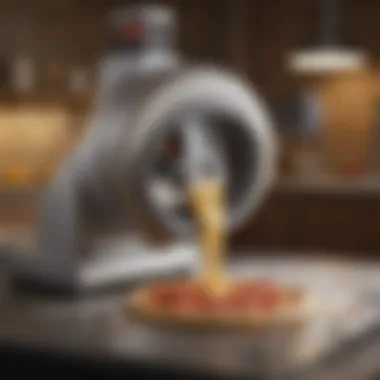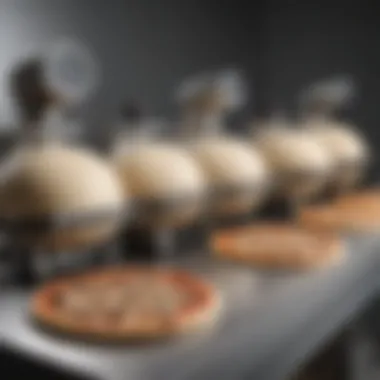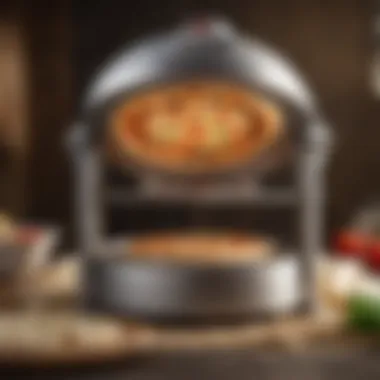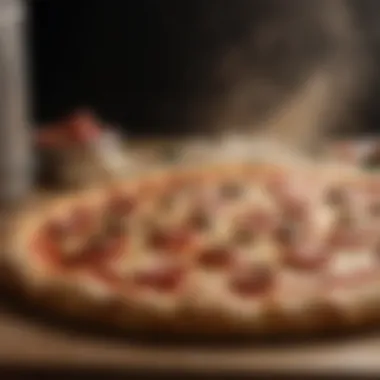Ultimate Guide to Pizza Dough Kneading Machines


Intro
Pizza, a beloved dish across the globe, starts with the essential foundation: dough. The process of kneading dough can be laborious, and that is where pizza dough kneading machines become incredibly useful. These machines save time and effort, ensuring consistent results without the wear and tear on your hands.
In the following sections, we will explore the various aspects of pizza dough kneading machines. This discussion will include their functionality, the benefits they offer, and the different types available. Additionally, we will cover selection criteria, key maintenance tips, and how these machines can elevate the pizza-making process for both novice cooks and experienced chefs.
Understanding Pizza Dough Kneading Machines
The significance of understanding pizza dough kneading machines transcends the simple task of making dough. It is about elevating culinary capabilities and enhancing the overall pizza-making experience. These machines streamline the process, offering benefits such as improved efficiency and consistency. By automating kneading, they free up time for cooks to focus on other important aspects of pizza preparation, like selecting toppings or experimenting with flavors.
Definition and Purpose
Pizza dough kneading machines are designed specifically for mixing and kneading dough used in pizza preparation. Their primary purpose is to develop gluten, a crucial protein that gives pizza its desired texture. Traditional kneading by hand can be labor-intensive and requires skill to achieve the perfect dough consistency. By utilizing a kneading machine, both novice cooks and seasoned chefs can achieve professional results with less physical effort.
Most machines come with multiple attachments, allowing them to take on various dough types used in pizza-making. From classic Neapolitan to thick pan pizza, these machines are equipped to handle a variety of recipes. In addition to their functional role, they represent a shift towards greater efficiency in culinary practices, showcasing how technology can assist in traditional cooking methods.
How Kneading Machines Work
Kneading machines operate via a straightforward mechanism. The user starts by adding the ingredients into the mixing bowl. The machine’s motor then agitates the bowl, mixing the flour, water, yeast, and other elements together. Different machines have distinct mechanisms; some use a spiral hook to knead the dough in a circular motion, while others may employ a paddle or whisk.
Most machines offer variable speed settings. Lower speeds typically focus on mixing, while higher speeds are intended for kneading. This variability allows users to customize their process according to the specific dough type and desired outcome.
Moreover, the design of these machines permits even heat distribution during the mixing process. This is essential as it supports the activation of yeast, contributing to proper fermentation and dough rise. When used correctly, pizza dough kneading machines can significantly reduce preparation time and help maintain the quality of the finished product.
The advancement of pizza dough kneading machines has changed the landscape of home cooking and professional kitchens alike, making it easier for anyone to produce high-quality pizza and expand skills in the culinary arts.
Historical Context
Understanding the historical context of pizza dough kneading machines is crucial for appreciating their impact on modern culinary practices. The evolution of these machines not only showcases technological advancement but also reflects changing consumer preferences towards efficiency and consistency in cooking. As pizza gained popularity across the globe, the demand for perfected dough preparation techniques increased, leading to innovations in kitchen appliances that cater to both amateur and professional chefs.
Evolution of Dough Preparation
Dough preparation has a long history, shaped by cultural influences and advancements in milling and baking technologies. Traditionally, dough was kneaded by hand, a labor-intensive process that required skill and time. As societies evolved, so did methods of food preparation. In the 19th century, the industrial revolution brought about mechanical mixers designed to save time in bakeries. These machines were pivotal in mass-producing bread and pastries and laid the groundwork for kneading machines specifically for pizza dough.
The introduction of electric motors in the early 20th century marked a significant shift. Enthusiasts and culinary experts began adapting these machines for home use. As pizza became a staple food option, particularly in the United States, the demand for easy-to-use machines catering to pizza dough preparation rose significantly. Consequently, manufacturers designed machines that could knead dough efficiently, ensuring consistent texture and flavor in the final product.
Prelude of Machines in Home Cooking
The rise of pizza's popularity in home cooking coincided with the advent of compact kneading machines, making it accessible for both novice and experienced cooks. Unlike traditional methods that required extensive effort and skill, these machines provided an easy alternative. Households began investing in stand mixers and spiral mixers, which offered a way to achieve professional-quality dough without needing professional training.
This transition signifies a major shift in culinary practices, emphasizing the blend of technology with traditional cooking. Users could now enjoy the satisfaction of homemade pizza with less physical labor and a reduced margin for error. Reviews from home cooks often highlight how these machines enable them to experiment with different dough types, enhancing creativity in their cooking practices.
"The ease of using a kneading machine has changed how I approach pizza making at home. I can focus on the flavors rather than the work of kneading dough by hand."
In summary, the historical context of pizza dough kneading machines reveals a journey from manual to mechanized preparation. This evolution highlights a growing trend towards efficiency in the kitchen while still valuing the culinary artistry of pizza-making.
Types of Pizza Dough Kneading Machines
Understanding the various types of pizza dough kneading machines is vital for those looking to enhance their baking experiences. Each type offers unique features that cater to specific needs and preferences in the kitchen. Choosing the right machine not only affects the quality of the dough but also impacts the efficiency of the overall pizza-making process. In this section, we will explore four common types of kneading machines: stand mixers, planetary mixers, spiral mixers, and dough sheeters.
Stand Mixers
Stand mixers are one of the most popular choices for home bakers. They are versatile and can handle a variety of mixing tasks aside from kneading dough. Typically, stand mixers come with a dough hook attachment designed for kneading.
These machines are great for small to medium batches of dough. Most have adjustable speed settings, allowing for gentle mixing or vigorous kneading as required. Using a stand mixer can save time and effort compared to hand kneading, and the consistency achieved often leads to a superior dough texture.
Planetary Mixers
Planetary mixers are essential in commercial kitchens due to their power and efficiency. They differ from stand mixers in that the mixing bowl remains stationary while the mixing attachment orbits around it. This motion ensures thorough mixing and kneading, which is particularly advantageous for large batches of dough.
Planetary mixers often come with multiple attachments, making them suitable for many applications, including whipping and mixing other ingredients. The motor power is typically stronger than that of stand mixers, making them ideal for heavy-duty tasks.
Spiral Mixers
Spiral mixers are primarily used in commercial environments where large quantities of dough are needed. They feature a spiral-shaped hook that works in conjunction with a stationary bowl. This design creates a gentle but effective kneading action.
The advantage of spiral mixers is that they preserve gluten development, leading to better dough quality. They are particularly beneficial when working with high-hydration dough, as they help avoid overworking the mixture. Many spiral mixers also come with a timer, allowing users to set precise kneading times for optimal results.


Dough Sheeters
Dough sheeters are specialized machines intended for rolling out dough into thin sheets. This can be particularly useful for pizza making, where evenly rolled dough is crucial for a consistent cooking surface.
While not a kneading machine per se, dough sheeters complement the kneading process by ensuring the dough is prepared correctly after it has been kneaded. They often feature adjustable thickness settings, allowing for precise control over the final product's thickness. This is especially beneficial for those who enjoy experimenting with different pizza styles, like Neapolitan or Sicilian.
In summary, understanding the types of pizza dough kneading machines can help you make informed decisions that enhance your overall pizza-making experience. Each machine serves a distinct purpose and caters to various baking needs.
Advantages of Using a Kneading Machine
Using a kneading machine can greatly enhance the process of making pizza dough. Many people may wonder why they should invest in a machine rather than simply using their hands. The reality is that the benefits of using such a device are considerable. It not only streamlines the dough preparation process but also helps achieve a superior dough quality. In this section, we will discuss three main advantages of using a kneading machine: consistency in dough texture, time efficiency, and improved gluten development.
Consistency in Dough Texture
One of the primary benefits of using a kneading machine is the consistency in dough texture it provides. Achieving the right dough texture requires precise kneading, which can be difficult to replicate by hand. Machines such as stand mixers and spiral mixers often come equipped with various speed settings. This allows for controlled kneading that can be adjusted according to the recipe requirements.
When dough is consistently kneaded, the result is a unified texture without lumps or dry spots. This is particularly important for experienced bakers who want their pizzas to have the same quality each time. A uniform dough texture also contributes to an even bake, resulting in pies that are not only visually appealing but also delicious.
Time Efficiency
Time is crucial in any kitchen, especially for home cooks and restaurant teams. Time efficiency is a key advantage of kneading machines over traditional methods. Many people find that kneading dough by hand can be a laborious and lengthy process.
With a kneading machine, the process becomes faster and more efficient. Some machines can knead dough in a matter of minutes, allowing cooks to focus their time on other aspects of pizza preparation. For example, once the ingredients are measured and placed in the machine, cooks can use that time to prepare toppings or preheat the oven. This saves not only time during the preparation of pizza but also allows for the ability to produce larger batches of dough in a shorter period.
Improved Gluten Development
The third significant advantage of using a kneading machine is improved gluten development. Gluten plays a crucial role in the texture and elasticity of pizza dough. Hand-kneading may not always develop gluten properly, especially if the kneading is inconsistent.
A kneading machine, on the other hand, can provide the necessary mechanical action to develop gluten effectively. As the machine works, it incorporates air and develops the gluten structure within the dough. This leads to a dough that is more elastic and better suited for stretching. A well-developed gluten structure results in a pizza crust that is chewy and has a desirable texture.
Selecting the Right Machine
Selecting the right pizza dough kneading machine is crucial for achieving the perfect pizza crust. Each machine varies in capability, so understanding what works best for one's specific needs is paramount. A proper assessment can save time and money, and ultimately lead to a better cooking experience.
When considering a pizza dough kneading machine, begin by assessing your own needs. Think about the volume of dough you typically prepare. Home cooks may require a smaller capacity, while professional chefs often need machines that can handle larger quantities efficiently. Understanding personal or business requirements will guide the selection process.
Assessing Your Needs
Different users have different needs based on their cooking habits. For a home cook, a smaller, compact machine might suffice, while a restaurant chef would likely benefit from a larger, robust option that can handle continuous use.
A critical question to ask is: How often will you use the machine? If it is for weekend pizza-making, a less expensive model may be appropriate. Conversely, frequent bakers might want a higher-end machine with greater durability and features.
Evaluating Machine Features
Once needs are assessed, evaluating specific machine features becomes necessary. Here are three pivotal characteristics that should guide the evaluation:
Motor Power
Motor power is a key feature that determines the machine's performance. A motor with higher wattage can handle thicker doughs more effectively, leading to better kneading results. Typically, machines range from 300 watts to 1500 watts. The higher the power, the more robust the mixing capabilities. Having a powerful motor can mean faster dough preparation and less strain on the machine itself, making it a beneficial choice.
However, powerful motors can also raise the price of the machine. It's important to weigh cost against utility when selecting this feature.
Capacity
Capacity is another significant factor to consider. Machines come in various sizes, with some able to handle as little as 2 quarts, while commercial models can mix up to 20 quarts. Knowing how much dough you regularly make will assist in choosing a suitable capacity.
A greater capacity allows the option to work with larger batches, which is a great advantage for professionals. But for casual cooks, a smaller capacity machine might be sufficient and more budget-friendly. Always check the maximum capacity to ensure it matches your needs.
Speed Settings
Speed settings provide flexibility. Many kneading machines offer multiple speeds for different stages of dough preparation. A lower speed is typically used for mixing ingredients, while a higher speed is better for kneading the dough.
Having adjustable speeds can contribute to better gluten development and dough consistency, making it a popular feature among many users. Nevertheless, it’s vital to test these settings to see if they align with your pizza-making process.
Budget Considerations
Understanding your budget is essential when choosing a kneading machine. Prices can vary significantly based on brand, features, and capacity. Setting a budget helps narrow down choices and can prevent overspending on features that may not be necessary.


Investing in a machine that aligns with your needs and capabilities is the way to go. Look for reliable brands with good customer reviews, and consider monitoring prices to find the best deal.
Operating Pizza Dough Kneading Machines
Operating pizza dough kneading machines is a critical aspect of mastering the art of pizza making. These machines automate the laborious task of kneading, ensuring consistent results and saving time. Understanding how to operate these machines effectively can enhance your cooking experience, allowing you to focus on other important aspects of your culinary creations.
To successfully operate a kneading machine, one must become familiar with its components and functionalities. This knowledge enables users to achieve the desired dough texture and consistency through correct usage. Moreover, effective operation can maximize the machine's lifespan, ensuring reliable performance over time.
In addition to the technical understanding, knowing how to use these machines properly can minimize the risk of common mistakes, leading to a more enjoyable kitchen experience. By recognizing the correct techniques and methods, bakers can achieve optimal results with each batch of dough.
Basic Machine Operation Steps
Operating a pizza dough kneading machine involves several straightforward steps. Here are the basic steps to follow:
- Preparation: Gather all your ingredients, including flour, water, yeast, and salt. Measure them according to the recipe requirements.
- Setup: Place the machine on a stable surface and plug it in. Ensure that all attachments are securely attached according to the manufacturer’s instructions.
- Loading Ingredients: Add the ingredients into the mixing bowl. Always follow the recipe to maintain the correct ratios.
- Setting Parameters: Adjust the speed settings according to the type of dough you are making. Most machines come with different speed settings for various kneading intensities.
- Kneading: Start the machine. Allow it to knead the dough for the recommended time. Keep an eye on the dough’s consistency; it should be smooth and elastic when finished.
- Stopping and Checking: Turn off the machine, and check the dough to ensure it has reached the desired texture. If not, knead for additional time as necessary.
- Remove Dough: Unplug the machine before removing the dough from the bowl. This prevents any accidents.
- Clean-up: After use, it’s crucial to clean the machine according to the manufacturer’s guidelines. Regular maintenance keeps the machine in good condition.
Common Mistakes to Avoid
When operating pizza dough kneading machines, it's easy to make some common errors that can affect the outcome of your dough. Here are some mistakes to avoid:
- Incorrect Ingredient Ratios: Adding too much or too little of any ingredient can lead to poor dough quality. Stick to precise measurements.
- Over-Kneading: Kneading for too long can make the dough too tough. Monitor the process closely to avoid this problem.
- Ignoring Manufacturer Instructions: Different machines have specific operating instructions. Not following these can lead to malfunctions or suboptimal results.
- Neglecting Cleaning: Failing to clean the machine after each use can cause residue buildup, affecting both performance and food safety.
- Using the Wrong Speed: Some doughs require gentle kneading, while others can handle more vigorous mixing. Always choose the right speed.
Tip: Regularly check the machine's manual for troubleshooting advice and operating tips. This can save time in the long run.
Overall, understanding the proper operation of pizza dough kneading machines is essential for both amateurs and seasoned chefs. Mastering these steps and avoiding common pitfalls can greatly enhance the dough-making process.
Maintenance and Care
Maintaining your pizza dough kneading machine is essential for ensuring its longevity and optimal performance. Like any kitchen appliance, these machines require regular care and cleaning. Proper maintenance not only extends the life of your investment but also significantly enhances the quality of the dough you produce. Incorporating routine maintenance practices into your cooking schedule can make a noticeable difference in your pizza-making experience.
Regular Cleaning Practices
Keeping your machine clean is crucial. After each use, it is important to remove any residue from the dough. Leftover dough can harden and become difficult to remove, potentially affecting the performance of the machine. Here are some effective cleaning practices:
- Unplug the Machine: Safety should always come first. Unplugging the machine ensures that you can clean it without any risk of accidental operation.
- Use a Soft Cloth: Wipe down the exterior with a damp cloth. Make sure not to use abrasive materials, as they can scratch the surface.
- Detach and Clean Components: Most kneading machines have removable parts, such as the bowl and hook. Wash these with warm, soapy water. If your machine is dishwasher safe, you can place certain components in the dishwasher. Always check the manufacturer's guidelines before doing so.
- Dry Thoroughly: After washing, make sure all parts are completely dry before reassembling the machine. Water left in components can cause damage over time.
Implementing these practices after every use will prevent the buildup of grime and ensure your machine remains in peak condition.
Troubleshooting Common Issues
Even with the best care, you may encounter problems with your kneading machine. Understanding common issues and how to resolve them can save time and frustration. Here are some frequent concerns:
- Machine Not Starting: Check if the machine is properly plugged in. Inspect the power outlet by plugging in another device to ensure it’s working.
- Unusual Noises: If your machine produces strange sounds during operation, it may indicate loose parts or a malfunction. Stop using it immediately and examine the components.
- Dough Sticking: If dough sticks to the mixing bowl, ensure you are using the correct flour to water ratio. A well-balanced recipe can prevent sticking and enhance mixing efficiency.
- Inconsistent Mixing: If dough is unevenly mixed, verify that the machine is functioning at the right speed. Adjust speed settings if necessary to achieve better results.
In case of persistent issues, it’s advisable to consult the user manual or reach out to customer support for assistance.
Regular maintenance can prevent 90% of common issues with kneading machines.
Integration with Traditional Techniques
In the realm of pizza making, the balance between modern technology and age-old methods is vital. The integration of traditional techniques with kneading machines ensures that while efficiency and consistency are prioritized, the rich culinary history and skills are not lost. Bakeries and pizzerias worldwide often use a combination of machines and manual techniques to achieve superior dough quality. This blend of methods brings several benefits, influencing both the final product and the cooking experience.
Combining Hand Kneading with Machine Use
While mechanical kneading offers speed and uniformity, hand kneading has an irreplaceable tactile quality. Many chefs and home cooks find that starting the kneading process by hand grants better control over the dough. The initial moments can be critical for assessing hydration and gluten development. Subsequently, transitioning to a machine can save time while allowing for the essential tactile experience during this critical stage.
Using a dough kneading machine after some hand work can lead to a more adept dough structure. For instance, hand kneading permits the cook to gauge the dough's elasticity more accurately, ensuring the dough reaches the desired texture. As one progresses, utilizing a kneading machine helps speed up the process, making it convenient for larger batches without compromising quality.
Maintaining Culinary Craftsmanship
Culinary craftsmanship is the backbone of traditional cooking. The art of dough making should be preserved even when utilizing modern machines. Not all aspects of pizza-making can be automated. Elements such as the precise feel for dough consistency and adjustment according to environmental changes depend largely on experience.
Incorporating machines doesn't mean abandoning these principles. Instead, it encourages a harmony between skill and technology. For example, while a kneading machine can streamline the mixing process, a skilled pizza maker can still refine the dough after machine use.
Moreover, understanding when to use each technique strengthens one’s ability to produce a consistently high-quality product. Thus, the pursuit of perfect pizza can be seen as an ongoing journey, merging the benefits of technology with a deep respect for traditional methods.
"Combining hand kneading and machine use leads to enhanced dough quality that respects tradition while embracing technology."


By blending these practices, culinary enthusiasts can preserve the authenticity of their craft. This respect for tradition allows for a deeper appreciation of the pizza-making process while achieving the efficiency that machines provide.
Ultimately, understanding the role of equipment in tandem with manual technique enriches both personal skill and enjoyment in the pizza-making experience.
- Better control over dough development
- Enhanced efficiency for larger batches
- Preserved tactile experience of traditional kneading
Achieving this balance not only honors the art of pizza making but also fosters innovation in cooking methods.
Popular Brands and Models
When selecting a pizza dough kneading machine, understanding the significance of popular brands and models is essential. The choice of brand often reflects reliability, performance, and user satisfaction. Different models come with various features, which can cater to diverse culinary requirements. Therefore, it is crucial to examine the leading brands and conduct a comparison of models to make an informed decision.
Overview of Leading Brands
In the realm of pizza dough kneading machines, several brands have established a reputation for quality and innovation. Notable brands include:
- KitchenAid: Renowned for its versatility, KitchenAid stand mixers are popular among home cooks. They offer multiple attachments, including dough hooks, that make kneading effortless.
- Hobart: Primarily used in commercial kitchens, Hobart mixers are built for durability and high capacity. Their spiral mixers are designed specifically for dough, ensuring consistent results.
- Bosch: Bosch kneading machines are praised for their powerful motors and efficient design. They often include unique features like built-in scales for accurate measurements.
- Emilia: Known for their compact design, Emilia machines take up less counter space, making them suitable for smaller kitchens.
- Zojirushi: This brand focuses on efficient home kneading machines. Known for their ease of use, Zojirushi models are ideal for novice cooks and busy home chefs.
These brands stand out because of their commitment to quality, which directly impacts the dough’s development and overall user experience.
Model Comparison
Choosing the right model involves comparing specific features and capabilities. Here are key attributes to consider:
- Motor Power: The power of the motor affects how well the machine can knead dough. A stronger motor can handle thicker dough, suitable for pizza.
- Capacity: When selecting a model, consider the batch size. For home use, a capacity of 4-6 quarts is adequate, while larger, commercial-grade machines may handle up to 20 quarts.
- Speed Settings: Varied speed settings allow for better control over the kneading process. Some machines have a slow start to mix ingredients gently, while others can reach higher speeds for efficient kneading.
Utilizing these factors can guide users in whittling down to the most appropriate machine for their needs. Doing so enhances both functionality and creativity in pizza dough preparation.
"Selecting the right brand and model can significantly affect your pizza dough experience, ensuring optimal results every time."
By understanding the terrain of brands and models, users can easily navigate through the options and find the perfect machine that aligns with their culinary ambitions.
User Experience and Feedback
User experience and feedback play a crucial role in understanding the effectiveness of pizza dough kneading machines. These insights not only inform potential buyers about product performance but also highlight usability and satisfaction among various user groups. Gathering feedback is essential for brands to improve their products and for users to make informed decisions based on real-world experiences.
In the realm of culinary equipment, the users vary widely—from casual home cooks to professional chefs. Each group has specific needs and preferences that influence their feedback. Surveys, online reviews, and culinary forums such as Reddit often present a wealth of information concerning different aspects of kneading machines, from ease of use to durability.
Reviews from Home Cooks
Home cooks generally prioritize user-friendly features in pizza dough kneading machines. Many reviews emphasize the importance of simplicity in operation. For instance, a machine that offers intuitive controls and clear instructions greatly enhances the cooking experience. Positive feedback often includes comments on:
- Time-saving capabilities: Users appreciate machines that minimize preparation time.
- Versatility: Many find value in machines that can knead not only pizza dough but other types of dough as well.
- Easy cleanup: A design that allows for easy disassembly and cleaning is frequently praised.
Home cooks often share their experiences on platforms like Facebook and specialized cooking websites. They frequently mention how machines like the KitchenAid Stand Mixer or Hamilton Beach Bread Maker have improved their pizza-making skills. These personal accounts illustrate real-life advantages that machines bring to the kitchen, helping prospective buyers visualize how a kneading machine could fit into their routines.
Professional Chefs’ Insights
Professional chefs provide a different perspective when it comes to pizza dough kneading machines. Their feedback often centers around advanced features and performance metrics that home users may overlook. Key considerations for chefs include:
- Professional-grade power: Many chefs seek machines with higher motor capacity to handle larger quantities of dough efficiently.
- Durability and construction quality: Given that they use these machines extensively, durability is a crucial element in their evaluation.
- Precision and consistency: Chefs often look for machines that ensure uniform dough texture, essential for high-quality pizza.
Insights from chefs are shared through blogs, culinary shows, and industry groups, providing an analytical lens on the performance of various machines. Renowned chefs frequently recommend brands like Hobart or Berkel, noting their impressive persistence over time and exceptional mixing capabilities.
"A great pizza dough kneading machine should behave like a silent partner in the kitchen—reliable, consistent, and ready to deliver every time." – A professional chef’s view on quality kitchen equipment.
Final Thoughts
The examination of pizza dough kneading machines wraps around the idea that technology can significantly transform culinary practices while preserving the essence of traditional cooking methods. Understanding the importance of these machines goes beyond mere convenience; they offer precision, consistency, and efficiency in pizza dough preparation. Cooks, whether novice or skilled, benefit from tools that enhance their ability to create high-quality dough. The advancements in kneading technology align with an increasing demand for better, faster, and more manageable cooking processes, making it crucial for anyone interested in culinary arts to consider their options carefully.
The Future of Dough Preparation
In contemplating the future of dough preparation, it is essential to recognize how culinary technology continues to evolve. The integration of high-performance kneading machines is central to this progression. More sophisticated designs use better materials and technology, ultimately improving performance and ease of use. With these advancements comes increased automation, allowing users to achieve consistent results without overlooking the critical aspects of kneading.
Home cooks may experience new models featuring settings adjusted specifically for various dough types, which opens up avenues for experimentation and learning. Additionally, the sustainability of ingredients and energy-efficient machines is becoming more paramount in consumer choices, as people become conscious of their environmental impact.
Choosing Technology versus Tradition
The debate around technology versus tradition in dough preparation is nuanced. On one hand, traditional methods have charm and depth, often cultivated in family kitchens for generations. Hand-kneading promotes a tactile connection with the dough that some enthusiasts cherish deeply. On the other hand, technology offers reliability and efficiency that can complement traditional techniques.
Some cooks are starting to blend both philosophies, utilizing machines for base preparation and then finishing with hand techniques to introduce personal touches. This hybrid approach respects the art of cooking while embracing modern conveniences. As technology continues to improve, the challenge will be to find a balance that maintains culinary traditions while leveraging technological advancements to enhance the pizza-making experience.
Moreover, as appliances become more accessible and affordable, the opportunity for people to engage in home baking grows, encouraging exploration and education in the world of pizza dough preparation.















